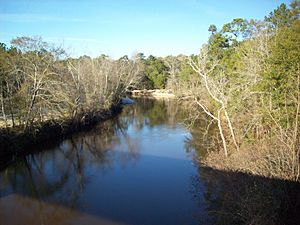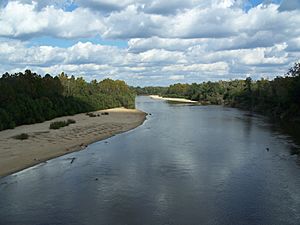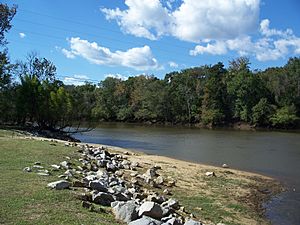Choctawhatchee River facts for kids
Quick facts for kids Choctawhatchee River |
|
|---|---|

Map of Choctawhatchee River
|
|
| Physical characteristics | |
| Main source | Barbour County, Alabama 31°21′40″N 85°33′10″W / 31.3612°N 85.5527°W |
| River mouth | Choctawhatchee Bay 30°24′14″N 86°07′25″W / 30.40380°N 86.12355°W |
| Length | 141 miles (227 km) |
The Choctawhatchee River is a long river in the southern United States. It flows for about 141 miles (227 km). The river starts in southeast Alabama and then goes through the Panhandle of Florida. Finally, it empties into Choctawhatchee Bay. The river and its surrounding land drain a huge area of about 5,350 square miles (13,856 sq km).
Contents
About the Choctawhatchee River


The Choctawhatchee River begins in Barbour County, Alabama. It starts as two separate parts, called the East Fork and the West Fork. These two parts join together near Newton, Alabama.
After joining, the river flows southwest through Alabama. It picks up water from smaller rivers called tributaries. These include the Little Choctawhatchee River and the Pea River.
The river then flows south into Florida. It passes through Holmes, Walton, and Bay counties. In Florida, other creeks like Holmes and Sandy join the river. The Choctawhatchee River ends when it reaches Choctawhatchee Bay. This bay then flows into the Gulf of Mexico near Destin, Florida.
Animals and Plants of the River
The Choctawhatchee River is home to many different kinds of fish. You can find several types of sunfish, channel catfish, and spotted bass. Other fish like Redhorse suckers and Carp suckers also live here.
An important fish in the river is the Gulf sturgeon. These large fish use the river to lay their eggs. Scientists have seen sturgeon as far upriver as Newton. They seem to like areas with limestone at the bottom for their eggs. Long ago, in the 1920s, catching sturgeon was a big business in Geneva.
The river also has many types of snails and freshwater mussels. Some of these are found only in the Choctawhatchee River.
Researchers have even reported seeing ivory-billed woodpeckers along the river. This bird is very rare, and some people thought it was extinct.
Most of the land around the Choctawhatchee River is covered in forests. You can see trees like southern pine, beech, and magnolia. The lower parts of the river have swampy areas. Here, you might see cypress trees with Spanish moss hanging from them. Alligators also live in the lower parts of the river.
River Water Quality
The Choctawhatchee River has mostly clean water. There are not many factories along its banks. Sometimes, the water can look cloudy. This is usually from dirt washing into the river from unpaved roads.
Groups like the Choctawhatchee, Pea and Yellow Rivers Watershed Management District work to keep the water clean. They helped put gravel on many dirt roads. This has made the water less cloudy.
Sometimes, people illegally dump trash or dead animals. But this usually does not cause big problems for the water quality in Alabama. The water quality there is often described as "good to very good."
In the Florida part of the river, the water quality can be a bit different. This is because of some wastewater treatment plants and animal farms. Some smaller streams that flow into the river in Florida are affected by wastewater.
River Flooding
The Choctawhatchee River has caused floods in the past. In 1865, a big flood called the "Lincoln Freshet" hit the town of Geneva. Many people moved to higher ground after this flood. Another major flood in 1929, called the Hoover Flood, washed away parts of Old Town Geneva.
Today, a levee helps protect Geneva from floods. This levee was built a long time ago. However, areas outside the levee have still flooded. After three floods in the 1990s, the government bought many homes in these areas. A flood in March 1990 caused over $88 million in damages.
In July 1994, similar flooding happened in Caryville, Florida. The river rose very high, covering most of the town. The government offered to buy homes, and many people moved away. The town's population dropped a lot after that flood.
River History
For thousands of years, the Choctawhatchee River was an important path for Native American tribes. It was used for travel and trade.
Later, a natural waterway connected Choctawhatchee Bay to Pensacola Bay. This allowed boats to travel between Pensacola, Florida and Geneva, Alabama. Even steamboats used the river to go as far upstream as Newton.
One important person was Sam Story, also known as Timpoochee Kinnard. He was a chief of the Euchee (Yuchi) Indians in the early 1800s. His people lived near the Choctawhatchee River in what is now Walton County. He was respected by both Native Americans and white settlers.
During the American Civil War, a Confederate steamboat called the Bloomer was on the river. In 1862, Union soldiers captured the steamboat in Geneva without a fight. They then sailed it down the river to the Bay.
Fun on the Choctawhatchee River
The Choctawhatchee River is a great place for canoeing. Many people enjoy paddling along its waters. Some call it an "undiscovered gem" because of its beauty.
There are several places where people can get to the river. There are also camping sites available. This makes it easy for people to enjoy outdoor activities on the river.
Images for kids




